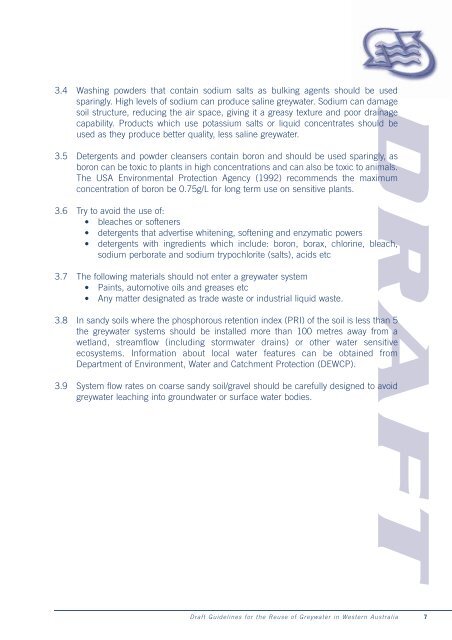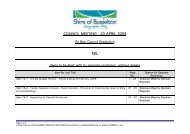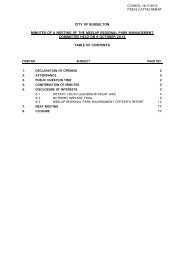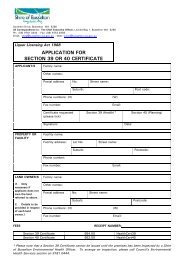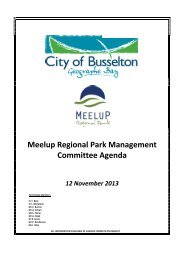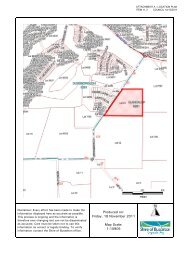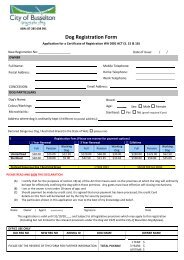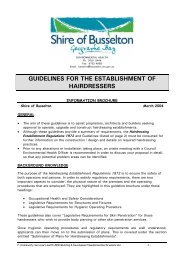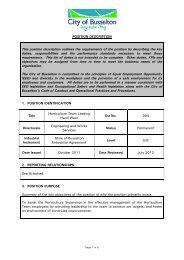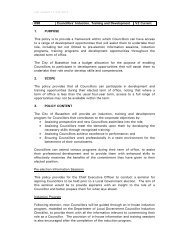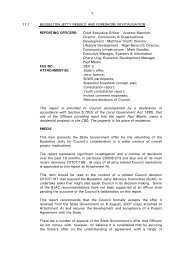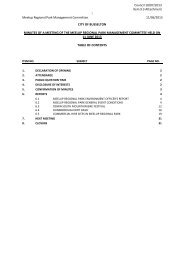Draft Guidelines for the Reuse of Greywater in Western Australia
Draft Guidelines for the Reuse of Greywater in Western Australia
Draft Guidelines for the Reuse of Greywater in Western Australia
You also want an ePaper? Increase the reach of your titles
YUMPU automatically turns print PDFs into web optimized ePapers that Google loves.
3.4 Wash<strong>in</strong>g powders that conta<strong>in</strong> sodium salts as bulk<strong>in</strong>g agents should be used<br />
spar<strong>in</strong>gly. High levels <strong>of</strong> sodium can produce sal<strong>in</strong>e greywater. Sodium can damage<br />
soil structure, reduc<strong>in</strong>g <strong>the</strong> air space, giv<strong>in</strong>g it a greasy texture and poor dra<strong>in</strong>age<br />
capability. Products which use potassium salts or liquid concentrates should be<br />
used as <strong>the</strong>y produce better quality, less sal<strong>in</strong>e greywater.<br />
3.5 Detergents and powder cleansers conta<strong>in</strong> boron and should be used spar<strong>in</strong>gly, as<br />
boron can be toxic to plants <strong>in</strong> high concentrations and can also be toxic to animals.<br />
The USA Environmental Protection Agency (1992) recommends <strong>the</strong> maximum<br />
concentration <strong>of</strong> boron be 0.75g/L <strong>for</strong> long term use on sensitive plants.<br />
3.6 Try to avoid <strong>the</strong> use <strong>of</strong>:<br />
● bleaches or s<strong>of</strong>teners<br />
● detergents that advertise whiten<strong>in</strong>g, s<strong>of</strong>ten<strong>in</strong>g and enzymatic powers<br />
● detergents with <strong>in</strong>gredients which <strong>in</strong>clude: boron, borax, chlor<strong>in</strong>e, bleach,<br />
sodium perborate and sodium trypochlorite (salts), acids etc<br />
3.7 The follow<strong>in</strong>g materials should not enter a greywater system<br />
● Pa<strong>in</strong>ts, automotive oils and greases etc<br />
● Any matter designated as trade waste or <strong>in</strong>dustrial liquid waste.<br />
3.8 In sandy soils where <strong>the</strong> phosphorous retention <strong>in</strong>dex (PRI) <strong>of</strong> <strong>the</strong> soil is less than 5<br />
<strong>the</strong> greywater systems should be <strong>in</strong>stalled more than 100 metres away from a<br />
wetland, streamflow (<strong>in</strong>clud<strong>in</strong>g stormwater dra<strong>in</strong>s) or o<strong>the</strong>r water sensitive<br />
ecosystems. In<strong>for</strong>mation about local water features can be obta<strong>in</strong>ed from<br />
Department <strong>of</strong> Environment, Water and Catchment Protection (DEWCP).<br />
3.9 System flow rates on coarse sandy soil/gravel should be carefully designed to avoid<br />
greywater leach<strong>in</strong>g <strong>in</strong>to groundwater or surface water bodies.<br />
DRAFT<br />
<strong>Draft</strong> <strong>Guidel<strong>in</strong>es</strong> <strong>for</strong> <strong>the</strong> <strong>Reuse</strong> <strong>of</strong> <strong>Greywater</strong> <strong>in</strong> <strong>Western</strong> <strong>Australia</strong><br />
7


